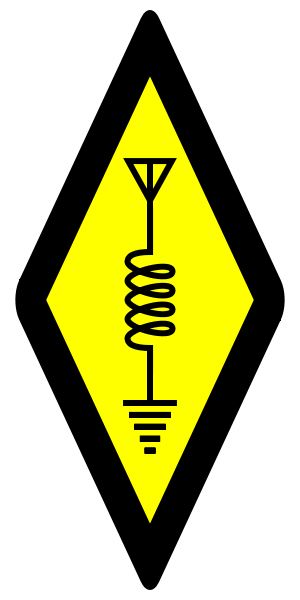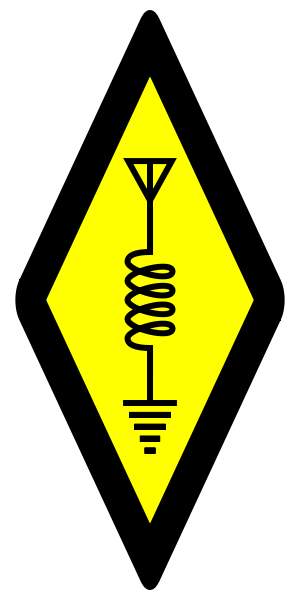

First let me introduce myself -- W2AEW. Amateur radio, commonly known as “ham radio” is a venerable hobby dating back to the inception of radio itself. With roots in the experiments of some of science’s greats, there is a homebrew aesthetic associated with radio that exists to this day despite the plethora of communications methods available to us now. While the lure of communicating around the globe drew many hams into the hobby in the past, the draw today is generally an interest in technology or public service, or even designing and building equipment.

The development of radio for communication was preceded by the telegraph, and many conventions were carried over into radio communications. These include the use of various codes and abbreviations as well as the term “ham” itself.
Since telegraphy required a physical connection, communications by telegraph were handled by professional operators. Many of these operators went on to handle radio communications, bringing their vernacular and culture with them. “Ham” in telegraphy was a derogatory term used to describe a poor operator, and was thus carried over to radio and used against amateur operators (possibly for good reason). Amateurs, in turn, owned the term and now wear it proudly.
As radio developed further, a need for regulating the available frequencies became apparent and amateur transmissions were restricted to a range of shorter wavelengths, essentially crippling them for long distance communications at the time. Hams were given access to “200 meters and down,” meaning frequencies whose wavelengths were shorter than 200m. In other words, anything above about 1.5MHz was fair game. These bands were deemed “useless” for commercial and government use. Unknown to the regulators at the time, the HF bands about 1.5MHz turned out to be ideal for world-wide communication via ionospheric propagation (lucky hams!). Even these modest frequencies were banned through World War I, but the restriction was lifted after.

Ham radio soon saw a flourishing that led to wireless communication between the UK and the USA, and subsequently many other locations around the world. This prompted a need for international standards, which were established by treaty around 1928.
Ham radio was interrupted once more during World War II and subsequently went through a few revisions to the allocated frequency bands, leading to the current standards. Today, about two million hobbyists worldwide participate in ham radio.
Modern Ham Radio
While Morse code proficiency had always been one of the requirements for an amateur radio license, it is no longer a requirement in many countries, including the US. Although not mandatory, many amateurs still enjoy operating Morse code, or “pounding the brass.” Amateur operators today communicate via Morse code, voice, pictures, video, and even digital data.
Ham operators can communicate with other hams around the world and even off it – many astronauts are also hams, and have been known to communicate with the more Earth-bound of us fairly often. ARISS, or the Amateur Radio on the International Space Station is a cooperative program between NASA and other international amateur radio organizations which fosters education primarily through scheduled amateur radio contacts between the International Space Station and school classrooms around the world, giving kids the opportunity to speak directly to astronauts in space. Amateur radio satellites rebroadcast ham radio transmissions, but even without them signals can be bounced off the atmosphere to reach far beyond the visible horizon.

Meeting people from remote locations is a lot of fun, but a large part of ham radio is local. This is due in part to the nature of shortwave radio, as well as power requirements. Many hams carry handheld radios with them all day, tuned to their favorite repeater. Also common are radios in cars and work or hobby places. Next time you see a car driving down the road, sprouting antennas, with a weird license plate code – that’s probably a ham. A common occurrence during the warmer months is the hamfest, which is a flea market where hams buy and sell all sorts of parts, tools, radio equipment, antennas and other items.
While high power transmitters help when communicating around the world, they’re not a requirement. World-wide propagation is governed primarily by sunspot and ionospheric activity as well as operating frequency and antenna efficiency, more so than by power alone. There are many hams that enjoy the challenge of communicating with hams thousands of miles away using a transmitter they built themselves which produces only milliwatts of power and fits in an Altoids mint tin or tuna can.
BTW
The cost of sending a message by telegraph was at one time quite exorbitant. As a result, messages by telegraph became concise, to the point, and made use of many acronyms that are today associated with internet chat and text messaging to save on word count. These too were brought to common usage in amateur radio. Imagine the mortification of the teenager who learns her grandpa was using terms such as OMG some 80 years ago. The Titanic tragedy highlighted the use of the wireless code “CQD”, which was an internationally recognized distress call. This later migrated into the more familiar “SOS.”
Emergency Situations
One of the most important functions of amateur radio is communication in times of distress. Hams are diverse, dispersed around the world, knowledgeable, and disciplined. In the event of a natural disaster or other emergency, amateur radio can provide a means of communication when centralized systems are down (overloaded cell towers, downed telephone lines, power outages, etc.).

Hams take this responsibility seriously, and can often be found assisting families and authorities. For example, the incident with the trapped Chilean miners made big news – but little was mentioned of the Radio Club de Chile and Radio Club Copiapo, who provided communication and equipment during the ordeal, going so far as to establish a radio communication system inside the mine itself. About 80 members installed and subsequently manned the equipment right from the start.
Emergency traffic always takes priority on the airwaves, and the likelihood of assistance is high if anyone listening can help. In some areas, operators can even be granted special license plates that qualify them as emergency vehicles.
Every year, hams around the world participate in an event designed to reinforce the ability to setup and operate an effective station using emergency power and temporary antennas, during a weekend long event called Field Day. Structured as both an exercise as well as a contest, it draws participation from hundreds of thousands of hams worldwide during the 4th full weekend of June.
Regulations and Licenses
Since radio equipment has the potential to interfere with other radio transmissions, operators must learn some information about radio, how it works, and the regulations governing amateur radio. There used to be six license classes in the US, but that has more recently been reduced to three: Technician, General, and Extra. Each subsequent class requires more knowledge and grants further privileges with regards to permitted transmission bands.

Ham operators abide by various rules of conduct such as refraining from strong language and keeping personal disputes off the air. They are required to identify themselves by their call sign periodically when they transmit; there is a public database of call signs that can be searched for basic information about any licensee. The combination of a strong code of ethics and personally identifiable transmissions helps to keep amateur transmissions civil.
Call Signs
Each licensee is assigned a call sign. Call signs are made up of three parts and look something like this: ZS1NAT. The structure of the call sign was prescribed by an international committee and allows for localized assignment of unique IDs. The prefix of the call sign, usually composed of two or three letters and numbers, define the operator’s country of origin, and often a specific region within the country. The suffix of the call sign, usually 1-3 letters, is uniquely assigned to the licensee.
Going back to our example, ZS1NAT, we can tell that the license was issued in South Africa (“ZS”). The “1” indicates the Western Cape. Finally, “NAT” is the unique suffix identifying the license holder.
Elmers and more…
In amateur radio, the term “Elmer” refers to a mentor, or to the act of mentoring others. This is integral to the ham radio spirit of helping others. Many more-experienced hams will volunteer their time to answer questions, provide tutoring or teach classes to anyone wishing to enter amateur radio ranks, or who simply wishes to learn more about it. The amateur radio community is a diverse network of clubs and individuals with expertise in a variety of areas. For some, sharing or publishing practical information is their way of giving back to the ham radio community. There are many engineering and scientific professionals involved in ham radio as well as many celebrities. Journalist Walter Cronkite, baseball pitcher Ron Swobada, TV/radio personality Jean Shepherd, Senator Barry Goldwater, and musician Joe Walsh are among the thousands of famous personalities who are or were hams. Nobel Prize winner for Physics Joseph Taylor is an avid ham, and has developed several modulation formats that are suitable for extremely weak signal communications.
Getting Involved
Hams are a friendly and inclusive bunch in general. There are local clubs in many places that will give you a place to learn or provide equipment you may not have access to. All you have to do is be courteous and you’re sure to find someone to help you along. Study up, get your license, and before you realize it a whole range of possibilities becomes available.


